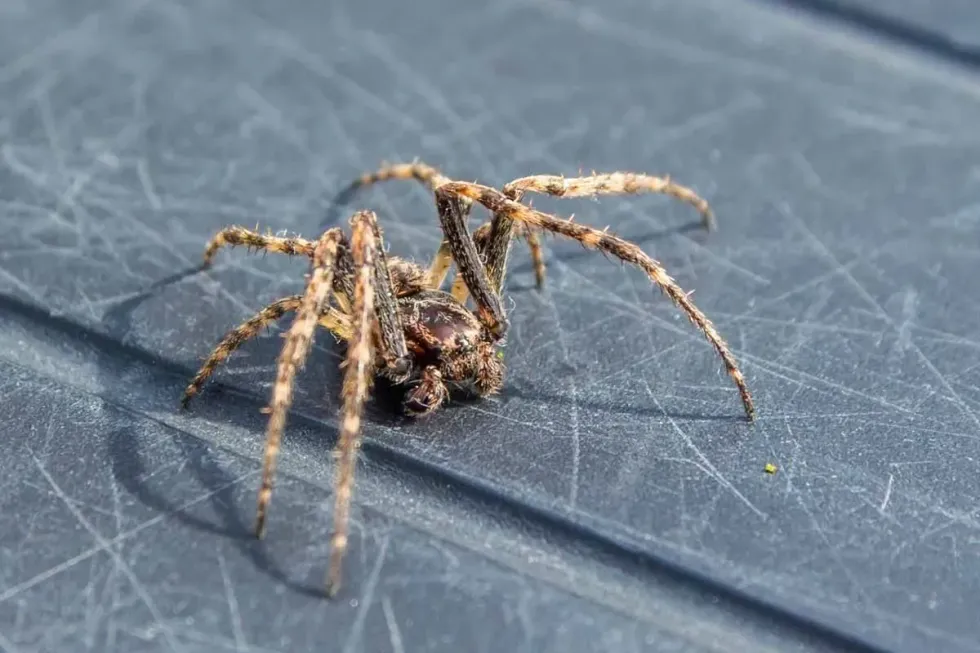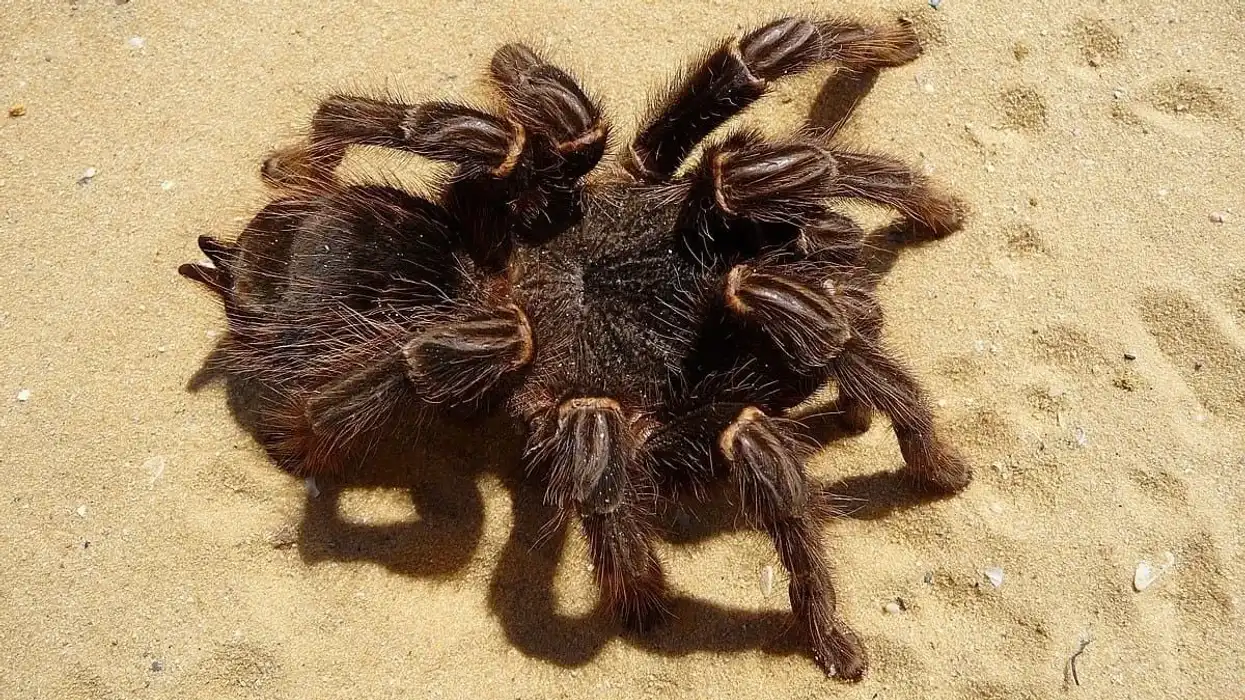The American house spider is the international name for common house spiders that are usually found in America. These creatures are scientifically known as Parasteatoda tepidariorum and are very abundantly seen in the geographical range of America.
These spiders are usually found in areas that are situated near human establishments and other secluded places where they are known to prey on a variety of insects and invertebrates that are easily found in their vicinity. This species has eight eyes which allow it to have a superior vision while hunting.
American house spiders are known to have really poor vision because of which they prefer catching their prey in webs rather than hunting them as they are unable to track any change of movement that is more than three or four inches away.
After reading these interesting American house spider facts, do check our other articles on the Carolina wolf spider and the sac spider.
American House Spider Interesting Facts
What type of animal is an American House Spider?
The American house spider (Parasteatoda tepidariorum) is one of the most encountered spider species that you will find in America, especially in North America.
What class of animal does an American House Spider belong to?
American house spiders are members of the Arachnida class and Arthropoda phylum. Their eight eyes are divided into four rows of two eyes. These spiders like to build their nest outside or inside houses, depending on where their food source is easily accessible.
How many American House Spiders are there in the world?
As we have already seen, American house spiders are an extremely common species in America which makes it almost impossible to find the exact number of these spiders that can be found around the world. American house spiders are abundant and do not have the threat of being extinct in the coming years.
Where does an American House Spider live?
American house spiders are known to have accepted houses and other human establishments as their favorite place to live.
The common house spider is one of the most widespread species of spiders that you are likely to come across, especially in North America. They are named so as they are abundantly found in and around America, whereas they are rarely seen in other places.
Although they have been named American house spiders as they are extremely common in America, they are found almost all over the world, earning the status of cosmopolitan creatures.
What is an American House Spider's habitat?
American house spiders have been put under the category of synanthropic creatures that are known to live and form their tangled webs near human establishments and greenhouses in secluded areas.
The common house spider prefers small secluded places such as areas behind windows and doors, cracks or loose walls, garages, and other places for building their web that is used to catch prey and is dark and undisturbed.
This spider is known to build webs with silk in different places such as corners of rooms, furniture, and dark spaces that will offer them enough prey.
Who do American House Spiders live with?
As soon as the male and female American house spiders find their partners for mating, they are usually known to share the same messy webs for long periods. The female American house spiders are also known to build their webs near one another to provide protection and security to one another.
However, females are also known to engage in fights with one another over territory.
How long does an American House Spider live?
American house spiders are just like many other spider species that are known to have a short lifespan. This spider species is known to live up to or have a lifespan of around one year but some species can live for up to seven years as well.
How do they reproduce?
These spiders have a really short life of around one year after they have reached sexual maturity.
American house spiders are known to mate, and the females lay around 150-200 eggs inside a single egg sac that is brown and the number of eggs inside can extend almost up to 400 in each egg sac. The female American house spiders are known to form around 15-20 such egg sacs throughout their lifetime.
Also, the babies, or spiderlings, are known to stay in the mother’s web for many days even after coming out of the sac.
What is their conservation status?
The American spiders are one of the most common house spiders that you will see in North America. With all this being said, American house spiders are extremely common creatures that have not been granted any special status under IUCN Red List or the US Federal list.
They are known to reproduce quickly, which also displays the fact that they are nowhere near being extinct, and their population almost remains intact.
American House Spider Fun Facts
What do American House Spiders look like?

The American house spider is a small-sized spider that can grow up to 1 in (2.5 cm) with its legs spread. Their color varies from dirty white to black.
They have long legs which are light yellow with brown or grey rings on them.
They also have a high abdomen in the front, which narrows down towards the spinnerets. These spiders are generally a dull brown and have patterns formed all over their body of different colors that represent or give a spotted appearance to these spiders, which is very clearly seen on their legs as compared to their body.
Their small size and dull brown coloration usually aid them to be almost invisible and easily blend into their surroundings.
They also resemble the widow spiders in their body shape and size but are less dangerous as compared to other species of their family Theridiidae. The legs of the males have an orange tint whereas the legs of the females have a yellow-colored appearance.
How cute are they?
These spiders can’t be called cute as they can appear scary to a lot of people.
How do they communicate?
There are almost no signs of any specific form of communication that is used between these spiders. The female American house spiders are generally known to reside together, but there is no record of any specific channels that are used to communicate with one another.
How big is an American House Spider?
An American house spider is amongst the smallest members of their family that are known to have a range of 0.15-0.19 in (3.8-4.7 mm) in length. The males are generally smaller in size at 0.15-0.18 in long, whereas the females are 0.20-0.24 in (5-6 mm) long.
How fast can American House Spiders move?
They do not chase their prey and are known to have normal speeds similar to other house spiders.
How much does an American House Spider weigh?
American house spiders are small creatures that are known to weigh up to 0.03 oz (0.9 g).
What are the male and female names of the species?
There are no specific names given to male and female species of American house spiders.
What would you call a baby American House Spider?
Female American house spiders are known to lay around 150-200 eggs on average in an egg sac and are known to produce around 15-20 egg sacs throughout their lifetime. These eggs hatch and the babies of American house spiders are generally regarded as spiderlings.
What do they eat?
American house spiders are carnivorous creatures that are known to use their webs for catching various pests. They are especially attracted to human establishments as there are a variety of insects and pests that can be a part of their diet.
These spiders consume a variety of insects including ants, flies, wasps, mosquitos, crickets, and grasshoppers, and are also known to attack cockroaches and butterflies. The female spiders are also known to use fly hanging near the web to attract skunks.
These spiders usually have a unique way of catching their prey. American house spiders are usually patient and wait until a large insect gets caught in their web, and then they are known to throw more silk on their prey to keep it more secure and then pull it into their web.
Are they harmful?
American house spiders are known to live near humans and so they are generally not very aggressive or dangerous towards humans even if they approach their web. They are only known to bite humans in self-defense when they feel threatened and are grabbed and squeezed.
They are also known to act dead as a last resort to safeguard or protect themselves.
Although their bites are deadly for small insects and other spiders, they do not cause much harm or danger to humans. Unlike their cousins, the black widow spiders, the venom of these spiders is not dangerous to humans.
Would they make a good pet?
No, this spider's bites can cause allergic reactions or itchiness, which should be shown to a doctor immediately.
Did you know...
American house spiders are those species of spiders that use similar mechanisms to other cobweb spiders that usually use the disturbances seen in their web to entangle their prey and then paralyze them through their teeth.
These spiders are viciously preyed upon by other spiders, including pirate spiders that belong to the family of Mimetidae and the other two species of jumping spiders, Metacyrba undata and Phidippus variegatus.
The assassin bug, Stenolemus lanipes, is known to feed only on the spiderlings of American house spiders and also sometimes hunts the adults.
When you compare American house spiders vs brown widow spiders, you might confuse them for being the same species, if you do not consider the subtle differences in their appearance. The house spider does not have a red hourglass marking on its underside, whereas the brown widow does.
Moreover, there are dark rings on the legs of common house spiders.
American House Spider bites
American house spiders, as we have already seen, are used to proximity to humans which accounts for the fact that they are rarely known to attack humans, and even then it is in self-defense.
However, their bites are not severe or painful as compared to bites of black widows, but they can cause severe pain for around 16 hours and can also cause systemic effects on humans. Their bites are usually not venomous as they rarely inject the venom they are carrying into humans.
Their bites do not cause any harm but are capable of causing itch bumps and allergies.
How to get rid of American House Spiders
Common house spiders are usually found in the spring and autumn seasons, whereas American house spiders are usually known to be seen in mid-winter when they start searching for a place to make their web. Although these spiders are of no harm to humans, they can be a nuisance.
So, to get rid of American house spiders in your house, the most effective remedy is to mix equal amounts of vinegar and water into a spray bottle and spray it all around the house to keep them away.
Here at Kidadl, we have carefully created lots of interesting family-friendly animal facts for everyone to discover! Learn more about some other arthropods including the six-eyed sand spider and the orb-weaver spider.
You can even occupy yourself at home by drawing one of our American house spider coloring pages.










